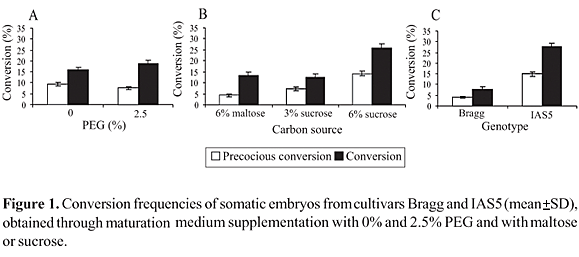Somatic embryogenesis is an efficient method for the production of target cells for soybean genetic transformation. However, this method still offers low percentages of plant regeneration, and perhaps is related to the maturation process and high morphological abnormalities of the matured embryos. This study aimed to identify a maturation medium that could contribute to the outcome of more efficient plant regeneration results. Embryogenic clusters, derived from cotyledons of immature seeds of the soybean cultivars Bragg and IAS5, were used as starting material for embryos development. Different maturation media were tested by using 6% maltose, 3% sucrose or 6% sucrose, combined with or without 25 g L-1 of the osmotic regulator polyethylene glycol (PEG-8000). The histodifferentiated embryos were quantified and classified in morphological types. Percentages of converted embryos were analyzed. Cultivar Bragg resulted in higher matured embryo quantities, but lower percentages were obtained for the conversion in comparison to cultivar IAS5. While the addition of PEG did not affect the number of embryos converted into plants, 6% sucrose enhanced the conversion percent significantly.
Glycine max; PEG-8000; sucrose; osmotic regulation


